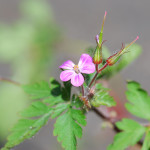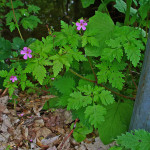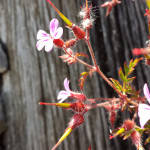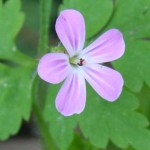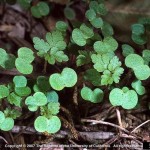Gallery:
- Herb Robert flower
- Herb Robert flowers and plant
- Herb Robert flowers
- Herb Robert flower
- Herb Robert seedlings
Common names:
Herb Robert, stinky Bob, red Robin, death come quickly, storksbill, crow’s foot, or Robert geranium
Scientific Name:
Geranium robertianum (syn. Robertiella robertiana)
Description:
Herb Robert is a low growing winter or spring annual or biennial ground cover with lacy, delicate, hairy light green to red spreading stems and leaves. It produces dense mats that choke native flora. Plants grow from short rosettes to about 1 foot tall. The leaves are deeply dissected and light green. The foliage turns red in late fall or in areas with high light exposure. Leaves are covered in glandular hairs, and have a strong odor when crushed, thus the common name ‘stinky Bob’. Stinky Bob has small, delicate, white or pink 5 petal flowers and blooms prolifically throughout the spring and fall. The fruit is a capsule. Seeds are brown and about 2 mm in length. Herb Robert has a very shallow, weak, fibrous root system which makes hand pulling easy.
Life cycle:
Height of mature plants
1 foot
Flower color:
Pink, White
Bloom time:
Spring through Fall
Look-a-likes:
Habitat:
Herb Robert is highly adaptable. It is found especially in moist forests with canopy closure but can also be spotted on dry rocky outcrops and everywhere in between. It’s becoming a significant garden pest in some areas. It is found from sea level to mid-mountainous areas in both the Cascades and Olympics, up to 4000 feet. It doesn’t require disturbance to move into a new area, making it a particular concern for intact ecosystems.
Impacts:
Herb robert invades forests where it displaces native herbaceous species and forms monocultures. It is highly aggressive and quick to spread, even in undisturbed settings and releases allelopathic chemicals which prevent native plants from growing and decreases diversity.
Noxious Weed Listing:
- WeedWise: Maintenance
- State of Oregon: Class B
- State of Washington: Class B
- Four County CWMA: Class C
Origin:
Europe, Asia and Northern Africa
Links:
Oregon Noxious Weed Profile
Washington Noxious Weed Profile
Invasive.org profile
CABI Invasive Species Compendium

